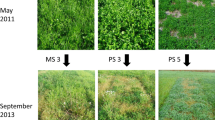Summary
Grain yield and yield components were studied in the three spring wheat genotypes HD 2160 (dwarf), Kalyansona (semi-dwarf) and C 306 (tall) in pure stands as well as in their binary mixed stands during two years. The grain yields of the three genotypes in pure stands ranked as follows: HD 2160 > Kalyansona > C 306. Four mixed stands, 3:1 HD:K, 1:1 HD:C in the first year and 1:1 K:C, 1:3 K:C in the second year out-yielded the pure stand of the better component genotype by 4.4, 2.7, 3.3 and 0.8 percent, respectively. Out of the nine mixed stands four in the first year and seven in the second year out-yielded the midmonoculture yields and the increases ranged from 1 to 7.6 percent. Mixed stands were more stable than pure stands.
The yield and yield components of the dwarf genotype HD 2160 scored less and those of the taller genotype C 306 scored higher in mixed stands. The semi-dwarf genotype Kalyansona yielded more with HD 2160 and less with C 306. Plant height but not high yielding ability conferred high competitive ability. With respect to competitive ability the three genotypes ranked as follows: C 306 > Kalyansona > HD 2160.
The results illustrate the importance of intergenotypic competition in increasing crop production and reducing genotype-environment interactions. Such studies are important to agronomists as genotypes with high competitive ability can be useful to combat the weed problem. They are also important to plant breeders for predicting the fate of genotypes with low competitive ability in heterogeneous populations.
Similar content being viewed by others
References
Allard, R. W. & J.Adams, 1969. Population studies in predominently self pollinating species. XII. Intergenotypic competion and population structure in barley and wheat. Am. Nat. 103: 621–645.
Allard, R. W. & A. D.Bradshaw, 1964. Implications of genotype-environment interactions in applied plant breeding. Crop. Sci. 4: 503–508.
Baker, R. J., 1977. Yield of pure and mixed stands of two spring wheat cultivars sown at five rates of seeding. Can. J. Plant Sci. 57: 1005–1007.
DeWit, C. T. & J. P.van denBergh, 1965. Competition between herbage plants. Neth. J. Agric. Sci. 13: 212–221.
Early, H. L. & C. O.Qualset, 1971. Complementary competition in cultivared barley (Hordeum vulgare L.). Euphytica. 21: 400–409.
Frankel, O. H., 1950. The development and maintenance of superior genetic stocks. Heredity 4: 89–102.
Jensen, N. F. & W. T.Federer 1965. Competing ability in wheat. Crop. Sci. 5: 449–452.
Khalifa, M. A. & C. O.Qualset, 1974. Intergenotypic competition between tall and dwarf wheats. I. In mechanical mixtures. Crop Sci. 14: 795–798.
Prasad, R. & S. N.Sharma, 1980. Systematic mixed stands of spring wheat cultivars, J. agric. Sci. Camb. 94: 529–532.
Prasad, R. & B. R.Rajeswara Rao, 1981. Allelopathy in spring wheat mixtures. Experientia 37: 1078.
Rajeswara Rao, B. R., 1980. Relative water use efficiency of pure and mixed stands of wheat genotypes. Ph. D. thesis. IARI. New Delhi (India).
Rajeswara Rao, B.R. & RajendraPrasad, 1982a. Studies on productivity of seed blends of two spring wheat cultivars under rainfed conditions. Z. Acker- und Pflanzenbau 151: 17–23.
Rajeswara Rao, B. R. & RajendraPrasad, 1982b. Productivity and nutrient uptake by two spring wheat cultivars in pure and mixed stands. Z.Acker- und Pflanzenbau 151: 235–244.
Reddy, M. R. & R.Prasad, 1977. Studies on lodging in wheat in relation to tallness of wheat genotypes, their mixed culture and nitrogen fertilization. Indian J. Agron. 22: 99–103.
Reddy, M. R. & RajendraPrasad, 1980. Effect of nitrogen and row direction on yield and yield componnents in pure and systematic mixed stand of wheat varieties differing in plant height Indian J. Agron. 25: 332–341.
Roy, Sk, 1974. Intra-specific competion and interaction in cultivated plants. Indian Biol. 6: 1–36.
Sage, G. C. M., 1971. Intervarietal competition and its possible consequences for the production of F1 hybrid wheat. J. agric. Sci. Camb. 77: 491–498.
Schutz, W. M., C. A.Brim & S. A.Usanis, 1968. Inter-genotypic competition in plant populations. I. Feed back system with stable equilibria in populations of autogamous lines. Crop Sci. 8: 61–66.
Sharma, S. N. & R.Prasad, 1978. Systematic mixed verses pure stands of wheat genotypes. J. agric. Camb. 90: 441–444.
Simmonds, N. W., 1962. Variability in crop plants, its use and conservation. Biol. Rev. 37: 422–465.
Trenbath, B. R., 1974. Biomass productivity of mixtures. Adv. Agron. 26: 177–210.
Author information
Authors and Affiliations
Rights and permissions
About this article
Cite this article
Rajeswara Rao, B.R., Prasad, R. Intergenotypic competition in mixed stands of spring wheat genotypes. Euphytica 33, 241–247 (1984). https://doi.org/10.1007/BF00022772
Received:
Issue Date:
DOI: https://doi.org/10.1007/BF00022772




